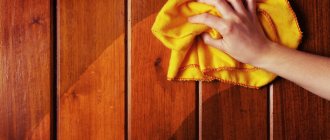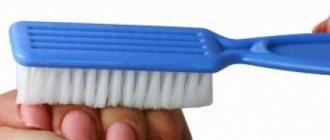The kitchen is one of the most popular places in the house - family holidays, get-togethers with friends - all these events take place in the kitchen, in an atmosphere of warmth and comfort. In addition, the kitchen is the face of any housewife, so everyone dreams of cleanliness and comfort reigning in this room.
Have you ever thought about what makes a kitchen sparkling clean and shiny - maybe neat household items, a pile of sophisticated cleaning products, or a robotic vacuum cleaner that does the cleaning on its own? In fact, everything is much simpler: the key to an ideal kitchen is a housewife who knows the basic rules for caring for furniture made using plastic.
What not to clean the kitchen
Plastic, even the strongest and most durable, is a rather inert material, but at the same time porous. This combination limits the choice of care products; otherwise, you will have to update the set after several cleanings.
- It is strictly forbidden to wash facades finished with any type of plastic with abrasive agents. The substance scratches and damages even the most durable surface - for example, steel, let alone plastic. This cleaning method is especially bad for glossy kitchens.
Abrasives include both preparations containing solid particles and tools - metal brushes, sponges, etc.
- Do not use chlorine-containing substances. Even in cases where you need to clean old grease stains with your own hands. Chlorine destroys the coloring pigment, and the plastic loses its color and shine, and eventually deteriorates.
- It is undesirable to use alcohol-based medications. At the same time, glossy facades in the kitchen quickly fade, and matte ones take on the appearance of being dusted with dust.
- Do not use aggressive household chemicals intended for washing stoves, plumbing fixtures, ovens, and so on. The formulations often contain very potent ingredients.
- A general requirement when caring for kitchen furniture is keeping it dry. Constant contact with water is even more destructive than splashes of hot fat or dye. Therefore, the best way to care for a plastic kitchen with your own hands is to immediately wipe off dirt with a dry or slightly damp cloth made of flannel, plush or microfiber.
What are plastic panels made of?
It seems that everything is clear that plastic panels are made of plastic, but what kind of material is it and what properties does it have? First of all, I would like to note the incredibly long service life of such panels, especially indoors. They are also completely safe for human health, so they can be easily installed in residential premises. The polymers used to make panels pass all tests and have government certificates.
For the most part, panels are available in two types: laminated - have a smooth, shiny surface, and matte - rough to the touch, without shine.
They are not affected by moisture, are extremely resistant to any chemicals and look modern. There is no need to talk about the color scheme: the number of colors is not limited, you can choose to suit every taste.
When choosing panels, decide in advance where and which ones will be installed; what suits the hallway will be absolutely unsuitable for the kitchen. For example, matte panels will be more difficult to clean from greasy stains if they are used to make a kitchen apron. PVC plastic panels in the kitchen must be laminated.
Care of laminated surfaces
Of all the types of plastic finishes, lamination is the least durable. Whether melamine film or PVC film is used for this, the result is the same: the coating is not resistant to mechanical damage and aggressive substances, so cleaning the kitchen set is not so easy.
- The best and almost universal remedy is warm water and soap. Baby soap is used as a washing component, since it is guaranteed not to contain fragrances or “extra” additives, or dishwashing gel. The latter is effective in the fight against fat, as it includes ingredients that dissolve fat and oil. This is the easiest way to “update” your headset.
The solution is prepared literally “by eye”. The optimal composition foams slightly, but removes dirt well.
To wash the facades, use a soft sponge or a soft cloth - flannel, microfiber. For heavy dirt, you can use a special soft brush.
- Pre-wetting of contaminants is not allowed - prolonged contact with water has a negative effect on the plastic. You can wash longer or increase the pressure slightly.
- If the grease is absorbed, then in order to wash the stain, use cleaning agents that include ammonia. This is a fairly weak alkali that can be used to wash off grease without causing damage to the plastic. Products containing alcohol and acids are excluded.
- To clean kitchen furniture, you can use many ready-made care products - “ABC of Cleanliness”, “Grosh” and so on. This preparation can be used with preliminary wetting. The holding time is specified in the instructions. To clean the kitchen without leaving streaks, after washing, you should clean the facades with a sponge soaked in clean water and always with a dry cloth. You also need to take care of the furniture from the inside: drawers and shelves also need to be washed with warm soapy water and wiped clean with your own hands. At the same time, pay attention not only to dirt, but also to the smell: the latter can be removed by wiping the box with a rag soaked in a vinegar solution and leaving the set open for ventilation.
How and with what to wash plastic panels
Plastic panels look great, of course, but in order for them to look perfect and continue to look after them, they need good care. There is, of course, nothing particularly complicated in this process, but you will still have to devote a little time, so first, familiarize yourself with some rules and procedures when washing panels:
- First of all, clear out the entire workspace, remove everything that hangs on the panels, that is, paintings, clocks, everything that can be removed. This is necessary so that you can clean the panels as best and quickly as possible; anything unnecessary will interfere and add a risk of injury.
- To protect the skin of your hands, be sure to wear rubber gloves; you will be working with detergents, and additional safety measures will not be superfluous.
- Near tables or not far from the stove, grease may accumulate in the seams between panels; before starting wet wiping, it can be removed with a stiff brush or rubber spatula.
- To work with a plastic surface, you can use soft foam sponges or flannel cloths.
- The water should be warm, not hot and not cold, but warm, pleasant to the hands.
- Plastic can be washed well from grease only with liquid gels; cleaning powders can leave micro-scratches on the plastic. Initially, the scratches are not visible, but over time, a kind of cobweb forms on the plastic surface, which cannot be washed.
- Before fully cleaning the surface, try the detergent somewhere on the edge to determine compatibility. If everything is fine, you can start cleaning.
- At the end of the work, all chemicals must be removed from the surface of the plastic and wiped several times with well-rinsed cloths.
- Finally wipe dry.
How to clean plastic panels? In household chemical stores there is a wide selection of different products for cleaning plastic panels. When choosing a product, carefully read what type of plastic it can be used for.
Any anti-grease product or window cleaning liquid will help you clean the plastic in the kitchen so that there are no traces left. The kitchen apron is made of plastic, and the walls in the kitchen are well washed with Sanita Anti-grease gel. The bottle lasts a long time. In some cases, in order to save the family budget, you can use homemade solutions to wash the panels. Read on to find out how to make them:
Caring for glossy surfaces
The appearance of glossy surfaces has to be “updated” much more often. The shiny plastic shows traces of grease even from the touch of your fingers. However, such a surface is easier to clean.
- Do-it-yourself major cleaning is carried out regularly and in exactly the same way as in a kitchen with laminated facades. However, in this case it is impossible to remove grease using products containing ammonia: ammonia will “eat” the gloss.
- To clean such a kitchen without streaks, be sure to use a completely dry cloth at the end of cleaning.
- But for daily cleaning, special care products or glass cleaning products are used. The latter perfectly remove grease from a glossy surface, which allows you to update the appearance of the facade at any time.
- To restore the shine of a glossy kitchen, it is best to use a special polish and a microfiber cloth.
Daily care and prevention
To maintain the neat appearance and shine of kitchen furniture, regular care and compliance with certain operating rules are necessary:
- After cleaning, the surface should be wiped dry, because due to excess moisture the material swells, mold may appear on it, and the PVC may peel off.
- It is recommended to install the headset in a place where there is no direct sunlight. Under the influence of ultraviolet light, the color on facades may lose saturation.
- Highly concentrated detergents must be diluted with water.
- When exposed to high temperatures, plastic becomes more flexible and expands. To prevent deformation, washing should be done with water at a temperature no higher than 40°C.
Many owners of glossy kitchen furniture recommend cleaning regularly using professional detergents to prevent stains from grease and other food from drying out.
How to update a plastic kitchen
Sometimes, despite all efforts, and sometimes thanks to them, plastic kitchens lose their attractiveness. Discolored spots, traces of dyes or touches of hot objects, traces of grease, and so on appear. You can cope with this problem with your own hands.
- You can radically update and replace the appearance of your kitchen using self-adhesive vinyl film. The material is simply glued to smooth facades. The film is very diverse: the color, the pattern, and even the texture can be chosen differently. It is as easy to care for as regular PVC film.
- You can update the look of the facade by gluing the molding yourself. Whether or not to paint the set depends on the chosen solution.
- A glossy kitchen can be updated using a special polishing paste: it completely removes scratches, abrasions, traces of grease and soot. You can save money and use regular tooth powder for polishing yourself - the result is the same.
Caring for a plastic kitchen is not difficult, you just need to follow a few simple rules: avoid prolonged contact with water and grease and wash with products that do not contain abrasive substances.
Buying a plastic headset
To sum it up, buying a plastic kitchen is a smart choice. The plastic set can be actively used for many years, it will not lose its color and bright shine, will not fade in the sun, will not lose its shape under the influence of moisture, heat and cold, and its facade will not peel off from the base and will not deform even in the most difficult conditions. And its brilliant color and beautiful design will always please the eye and lift your spirits.
If you decide to purchase a kitchen made of plastic, we invite you to familiarize yourself with the product catalog posted on our website. A wide range of products, a bright color palette, the shortest production time and an affordable price can satisfy even the most demanding taste.
Washing kitchen furniture
To clean the kitchen you will need: gloves, sponges, soft cloths, a brush and household chemicals.
The kitchen will not look cozy if it is in disrepair. In order to wash the furniture in this room, preliminary preparation will be required.
You need to unload all the dishes from the kitchen furniture and wipe them inside. In places of heavy contamination, the racks are washed with soapy water using a sponge. It is necessary to work with gloves, since many effective products have an aggressive environment.
The shelves are washed separately using the same universal detergents. After this, you should take clean water into a large plastic basin, rinse all the furniture and rub it until it shines.
The next stage involves ventilation of furniture structures. If any odor persists after general washing inside the cabinets, wipe them with a cloth soaked in table vinegar. This almost always gives 100% effect. All! You can forget about the unpleasant smell for a long time.
The contents of the cabinets must also be washed, wiped and dried. Any home dishwasher is ideal for these purposes. Now you need to wash the cabinets from the outside. After this, small pieces of chalk or bags of rice should be placed in them. They have the property of absorbing water. This measure is necessary in order to completely eliminate dampness.
Overview of special tools and devices
Professional products sold in household chemical departments.
Follow the instructions! Remember, acid and abrasive powders negatively affect PVC!
Among the many cleaning products, the following are reliable and effective:
- The brand offers a LOC product that can clean dirt on any surface. The product is safe, environmentally friendly;
- Muskul. A powerful liquid product that will leave your bathtub, faucets and trim sparkling. It is not afraid of either limescale deposits or stains from rust;
- creamy paste solution for glossy surfaces. Removes stubborn, stubborn stains without leaving scratches or damage. Knows how to eliminate the unpleasant consequences of bad habits of apartment owners - removes yellowness from tobacco smoke;
- Proper. An indispensable assistant in the kitchen. Helps keep panels in order by dissolving grease and organic contaminants;
- The cleaning spray will save the slatted ceiling and walls from fungal pests thanks to its antiseptic effect. Can wash panels, eliminating any dirt.
- Household chemicals for whitening plastic window sills
- Useful tools for cleaning windowsills
An inexpensive and easy-to-handle melamine sponge has cleaning capabilities. Safe to use on all types of surfaces and materials. Easily removes limescale deposits, dirt, stains, traces of ink and marker.
Tools you'll need
To clean plastic from nicotine deposits, dust, grease and other contaminants, you must use only gentle, soft tools. Suitable for this:
— hard brush/rubber spatula;
- sponge made of foam rubber or melamine;
- latex gloves;
- cotton rag or other soft one;
- mop.
REFERENCE! Do not use products containing abrasives, scrapers, hard brushes, or pipe cleaners. Such tools can damage the surface. In addition, to clean plastic, you cannot use products containing acids, as they will leave streaks and stains.
Three home recipes
To wash plastic items, there are simple methods using available materials. They do an excellent job with this type of task.
- High fat laundry soap. You need to grate half the piece on a coarse grater and dissolve it in warm water. Apply the resulting paste to the stains. After half an hour, rinse with warm water and a hard sponge. True, the method is more suitable for eliminating fat, not from exposure to the sun or other chemical reactions.
- Washing powder and soda ash. Mix one tablespoon per liter of water. Rub the mixture onto yellowed areas on the windowsill or any plastic object. And leave it for several hours. Then wash off with warm water.
- Alcohol or acetone. The product is well suited for plastic windows. But the method is quite dangerous and can damage the surface. Under no circumstances should they be used on painted objects, as these solutions will corrode the paint. Therefore, it is better to first try in a small hidden area. And use it little by little. If you don't have alcohol on hand, nail polish remover may work.
How to properly attach PVC panels to the wall
To understand how to attach plastic panels to the wall, remember a few useful tips:
Cut the elements themselves, placing them face up. To protect your eyes, be sure to wear construction glasses while cutting parts. When driving nails, it is important to hit the nail head clearly, otherwise dents will remain. It will be impossible to correct such a defect. Do not remove the protective film until the installation process is complete to avoid leaving dirty marks on the trim. After installation, wash the walls only with soapy water so as not to spoil the structure or design.
- Can a husband and wife be godparents?
- Calcivirosis in cats - causes and signs, symptoms, diagnosis and treatment regimen
- How to tell if you have tapeworms or pinworms
On a wooden sheathing
The question of how to attach plastic panels to the wall can be solved by lathing made of wood. The slats must be screwed at a distance of about fifty centimeters. The wooden beams must be perpendicular to the direction of the PVC: if the parts of the future interior are located vertically, then it is best to nail the wooden structure horizontally.
- First of all, install the fittings. First fasten the outer and inner corners to the surface, then the final element - the ceiling plinth, and finally - the molding with lamellas.
- Next, install the first part connecting the fastening elements. Secure with nails or staples from the side of the wide mounting flange.
- To ensure that the entire structure does not turn out crooked, check the first before attaching the next part. It should stand straight.
- Mount the narrow shelf of the second element to the first, leaving no gaps.
- So sequentially attach all the PVC panels. Only the very last element differs: it must be inserted with force to fix the entire structure. If the size does not fit the remaining space, trim the piece along the trim with a knife.
Using a metal frame
If there is always high humidity in the room, for example, in a sauna or bathroom, then the wood will quickly swell and you will have to do the repairs again. How to attach plastic panels to the wall in this case? Metal mounting structures are suitable. To simplify the installation process of the cladding, special clips are used. Thanks to them, you can easily remove interior elements and attach others.
When installing sheathing, be aware that the material may expand as temperatures change. When using a wide beam, sound insulation or insulation can be added to the free space. So simple plastic panels will help solve several problems at once: create a tasteful interior and retain heat inside the room.
- Compensation for using a personal car for business purposes
- 8 warning signs of heart attack in women
- Flaxseed flour
Installation of PVC panels without lathing using liquid nails
For smooth walls, use construction adhesive, but during such repairs, wear a respirator and ventilate the room. The benefits will outweigh all temporary inconveniences. “Liquid nails” do not affect plastic and dry quickly, which makes it possible to correct details on the wall. This glue is environmentally friendly and does not depend on changes in climatic conditions (temperature and humidity changes).
- Before gluing the panels, it is necessary to prepare the walls: remove old wallpaper, tiles and plaster, smooth out any inaccuracies and prime the surface.
- At the very beginning, remove the slabs from the packaging for thirty minutes to allow adaptation to the humidity in the air.
- Prepare the glue itself: cut off the tip, put on the cap, open it and install the product in the construction gun.
- Draw dots, a lattice, or a zigzag pattern on the wall.
- At the time of gluing, press the part against the wall so that the glue will better adhere to the entire element evenly. You can use a rubber roller. The first couple of minutes it is easy to adjust the position of the structure, and after 20 minutes the glue will set.
- The final step is to “seal” the seams between the PVC parts and other elements of the bathroom with sealant. The wall profile is ready.











